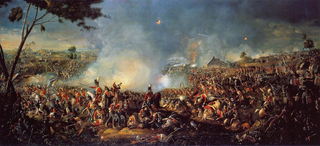
The Battle of Waterloo was fought on Sunday 18 June 1815, near Waterloo, marking the end of the Napoleonic Wars. A French army under the command of Napoleon was defeated by two armies of the Seventh Coalition. One of these was a British-led force with units from the United Kingdom, the Netherlands, Hanover, Brunswick, and Nassau, under the command of the Duke of Wellington. The other comprised three corps of the Prussian army under Field Marshal von Blücher. The battle was known contemporarily as the Battle of Mont Saint-Jean in France or La Belle Alliance in Prussia.
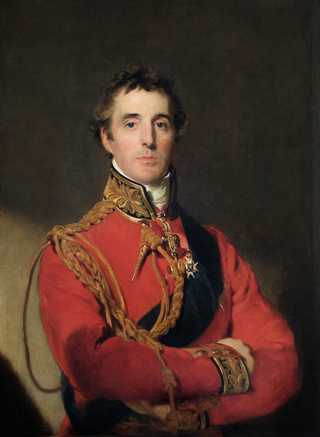
Field Marshal Arthur Wellesley, 1st Duke of Wellington, was an Anglo-Irish statesman, soldier, and British Tory politician who was one of the leading military and political figures of 19th-century Britain, serving twice as prime minister of the United Kingdom. He is among the commanders who won and ended the Napoleonic Wars when the Seventh Coalition defeated Napoleon at the Battle of Waterloo in 1815.

Sir David Wilkie was a Scottish painter, especially known for his genre scenes. He painted successfully in a wide variety of genres, including historical scenes, portraits, including formal royal ones, and scenes from his travels to Europe and the Middle East. His main base was in London, but he died and was buried at sea, off Gibraltar, returning from his first trip to the Middle East. He was sometimes known as the "people's painter".

Apsley House is the London townhouse of the Dukes of Wellington. It stands alone at Hyde Park Corner, on the south-east corner of Hyde Park, facing towards the large traffic roundabout in the centre of which stands the Wellington Arch. It is a Grade I listed building.
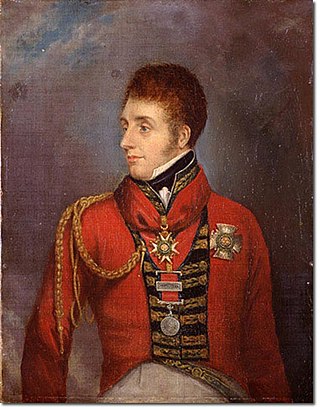
Major-General Sir William Ponsonby was an Anglo-Irish politician and British Army officer who served in the Peninsular War and was killed at the Battle of Waterloo.

Daniel Maclise was an Irish history painter, literary and portrait painter, and illustrator, who worked for most of his life in London, England.
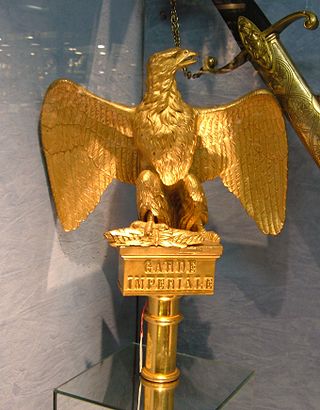
The French Imperial Eagle refers to the figure of an eagle on a staff carried into battle as a standard by the Grande Armée of Napoleon during the Napoleonic Wars.

General Sir Edward Paget was a British Army officer.

Sir William Allan was a distinguished Scottish historical painter known for his scenes of Russian life. He became president of the Royal Scottish Academy and was made a Royal Academician.

Captain William Hay CB was the second and last junior Joint Commissioner of Police of the Metropolis, one of two heads of the London Metropolitan Police.
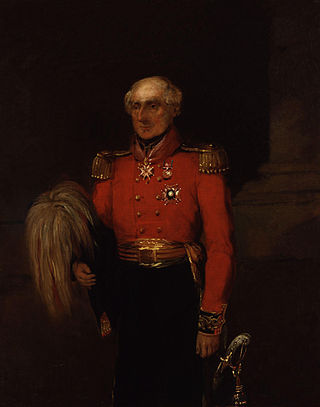
Lieutenant-General Sir Colin Campbell was a British Army officer and colonial governor.
William Salter was an English portrait painter of the 19th century. His best known work was a painting of 83 people at a banquet in 1836 organised by the Duke of Wellington to celebrate their victory at the Battle of Waterloo. The painting is called The Waterloo Banquet 1836 and today is at Apsley House.

The Duchess of Richmond's Ball was a ball hosted by Charlotte, Duchess of Richmond in Brussels on 15 June 1815, the night before the Battle of Quatre Bras. Charlotte's husband Charles Lennox, 4th Duke of Richmond, was in command of a reserve force in Brussels, which was protecting that city in case Napoleon Bonaparte invaded.

Colonel Sir Felton Elwell Hervey-Bathurst, 1st Baronet,, was an officer in the British Army during the Napoleonic Wars.
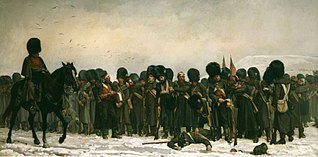
Calling the Roll After An Engagement, Crimea, better known as The Roll Call, is an 1874 oil-on-canvas painting by Elizabeth Thompson, Lady Butler. It became one of the most celebrated British paintings of the 19th century, but later fell out of critical favour.

Allegory of Waterloo, also known as Triumph of the Duke of Wellington or the Triumph of Great Britain after the Battle of Waterloo, was a monumental painting by British artist James Ward, completed in 1821, and now lost.
The Wellington Collection is a large art and militaria collection housed at Apsley House in London. It mainly consists of paintings, including 83 formerly in the Spanish royal collection, given to Arthur Wellesley, 1st Duke of Wellington, who was Prime Minister as well as the general commanding the British forces to victory in the Napoleonic Wars. It also includes his collection of furniture, sculpture, porcelain, the silver centrepiece made for him in Portugal around 1815, and many other artworks and memorabilia relating to his career.

The Last Muster is an 1875 oil painting by Sir Hubert von Herkomer, based on his wood engraving Sunday at the Chelsea Hospital published in The Graphic on 18 February 1871. The painting is in the Lady Lever Art Gallery in Port Sunlight, Wirral.
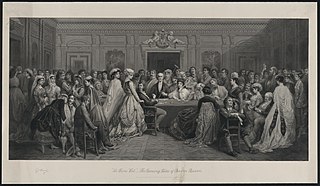
Salon D'Or, Homburg, is an 1871 oil painting by William Powell Frith. It is held by the Rhode Island School of Design Museum in Providence, Rhode Island.
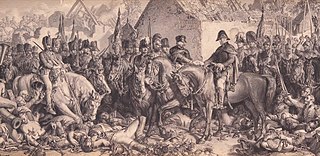
The Meeting of Wellington and Blücher after the Battle of Waterloo is a monumental wall painting by Irish painter Daniel Maclise, completed in 1861. It depicts the moment towards the end of the Battle of Waterloo on 18 June 1815, when the commanders of the allied British and Prussian armies, the Duke of Wellington and Marshal Blücher, met near La Belle Alliance. Measuring 3.68 by 13.92 metres, it is displayed in the Royal Gallery at the Palace of Westminster.




















